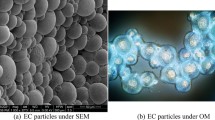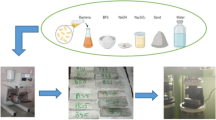Abstract
Macro-defect-free (MDF) cement composites are high-strength materials produced by applying high shear to cement-polymer pastes, using twin roller mill under moderate pressure and temperature. However, sensitivity toward moisture, specifically degradation of strength on water exposure, is a serious problem associated with MDF cement composites. To address this issue, a novel formulation of Portland cement-based MDF cement composites with addition of potassium methyl siliconate (PMS)–hydroxypropyl methylcellulose (HPMC) copolymer and pulverized fly ash (PFA) is presented. The experimental program involves preparation of first, HPMC/PMS copolymer using magnetic stirrer and then mixing it with cement and PFA to make MDF composites. PMS proportion varies from 0 to 4% in steps of 1%, while 30% PFA was added as cement replacement. Control mix contained 100% cement without PFA and PMS polymer. MDF composite sheets were prepared through twin roller mill and then characterized using FTIR, TGA/DTG and SEM. Flexural strength of MDF composites sheets were estimated by three-point loading test with 1 mm min−1. loading ramp. Results revealed that PFA/PMS addition have beneficial effects on the flexural strength, temperature and water resistance characteristics of MDF cement composites. FTIR spectroscopy showed the formation of new peaks related to Si–O–Si and Si–CH3 stretching. PFA/PMS-based MDF composite specimen showed comparatively higher quantity of calcium silicate hydrate gel and lower calcium hydroxide content which resulted in denser microstructure. Inclusion of 30% PFA and 3% PMS in MDF cement matrix produced composites with 52% improved flexural strength and 80.3% water resistant properties as compared to reference MDF mix at 28 days.
Graphical abstract














Similar content being viewed by others
Abbreviations
- OPC:
-
Ordinary Portland cement
- PFA:
-
Pulverized fly ash
- PMS:
-
Potassium methyl siliconate
- HPMC:
-
Hydroxy propyl methyl cellulose
- PVA:
-
Polyvinyl alcohol
- CAC:
-
Calcium aluminate cement
- C3S:
-
Tricalcium silicate/alite
- C2S:
-
Dicalcium silicate/belite
- C3A:
-
Tricalcium aluminate
- C-S-H:
-
Calcium silicate hydrate
- FTIR:
-
Fourier transform infrared spectroscopy
- TGA/DTG:
-
Thermogravimetric/Differential thermo-gravimetric
- XRD:
-
X-ray diffraction
- SEM:
-
Scanning electron microscopy
References
Tomar P, Lakhani R, Chhibber VK, Kumar R. Macro-defect free cements: a future oriented polymer composite materials for construction industries. Compos Interfaces. 2018;25(5–7):607–27. https://doi.org/10.1080/09276440.2018.1439637.
Desai PG, Lewis JA, Beintz DP. Unreacted cement content in macro-defect-free composites: impact on processing-structure-property relations. J Mater Sci. 1994;29(24):6445–52. https://doi.org/10.1007/BF00354002.
Ekincioğlu O, Özkul MH, Struble LJ, Patachia S. State of the art of macro-defect-free composites. J Mater Sci. 2018;53(15):10595–616. https://doi.org/10.1007/s10853-018-2328-y.
Chandrashekhar GV, Cooper VI, Shafer MW. Dielectric properties of macro-defect-free (MDF) cements. J Mater Sci. 1989;24(9):3356–60. https://doi.org/10.1007/BF01139065.
Dell’Aversano R, D’Amore A. Tailoring the properties of calcium aluminate macro-defect-free cements: from brittle to ductile behavior. J Mater Eng Perform. 2019;28(11):7068–74. https://doi.org/10.1007/s11665-019-04430-3.
Kalina L, Matoušek D, Šoukal F. Utilization of XPS analysis for the characterization of mechanochemical activation in polymer-cement composite materials. Adv Mater Res. 2014;1000:231–4. https://doi.org/10.4028/www.scientific.net/AMR.1000.231.
Drabik M, Slade RC. Macro defect-free materials: modification of interfaces in cement composites by polymer grafting. Interface Sci. 2004;12(4):375–9. https://doi.org/10.1023/B:INTS.0000042335.65518.11.
Alfani R, Colombet P, D’amore A, Rizzo N, Nicolais L. Effect of temperature on thermo-mechanical properties of macro-defect-free cement-polymer composite. J Mater Sci. 1999;34(23):5683–7. https://doi.org/10.1023/A:1004701529490.
Wu Q, Zhu Z, Li S, Wang S, Chen B. Effect of polyacrylic ester emulsion on mechanical properties of macro-defect free desulphurization gypsum plaster. Constr Build Mater. 2017;153:656–62. https://doi.org/10.1016/j.conbuildmat.2017.07.109.
Drabik M, Billik P, Galikova L. Macro defect free materials; the challenge of mechanochemical activation. Ceram-Silik. 2012;56(4):396–401.
Bortzmeyer D, Frouin L, Montardi Y, Orange G. Microstructure and mechanical properties of macrodefect-free cements. J Mater Sci. 1995;30(16):4138–44. https://doi.org/10.1007/BF00360721.
Chandrashekhar GV, Shafer MV. Polymer impregnation of macro-defect-free cements. J Mater Sci. 1989;24(9):3353–5. https://doi.org/10.1007/BF01139064.
Chu TJ, Robertson RE. Viscoelastic behaviour of macro-defect-free cement. J Mater Sci. 1994;29(10):2683–90. https://doi.org/10.1007/BF00356818.
Igarashi H, Takahashi T. The influence of moisture on the expansion of macro-defect-free cements. MRS Online Proc Libr. 1991;245(1):173–8. https://doi.org/10.1557/PROC-245-173.
Donatello S, Tyrer M, Cheeseman CR. Recent developments in macro-defect-free (MDF) cements. Constr Build Mater. 2009;23(5):1761–7. https://doi.org/10.1016/j.conbuildmat.2008.09.001.
Lewis JA, Boyer MA. Effects of an organotitanate cross-linking additive on the processing and properties of macro-defect-free cement. Adv Cem Based Mater. 1995;2(1):2–7. https://doi.org/10.1016/1065-7355(95)90033-0.
Mojumdar SC, Mazanec K, Drabik M. Macro-defect-free (MDF) cements. J Therm Anal Calorim. 2006;83(1):135–9. https://doi.org/10.1007/s10973-005-7045-5.
Ekincioglu O, Ozkul MH, Struble LJ, Patachia S. Optimization of material characteristics of macro-defect free cement. Cem Concr Compos. 2012;34(4):556–65. https://doi.org/10.1016/j.cemconcomp.2011.11.003.
Wang Z, Huang Z, Yang T. Silica coated expanded polystyrene/cement composites with improved fire resistance, smoke suppression and mechanical strength. Mater Chem Phys. 2020;240: 122190. https://doi.org/10.1016/j.matchemphys.2019.122190.
Vanin DVF, Andrade VD, Fiorentin TA, Recouvreux DDOS, Carminatti CA, Al-Qureshi HA. Cement pastes modified by cellulose nanocrystals: a dynamic moduli evolution assessment by the Impulse Excitation Technique. Mater Chem Phys. 2020;239: 122038. https://doi.org/10.1016/j.matchemphys.2019.122038.
Zanfir AV, Nenu N, Voicu G, Badanoiu AI, Ghitulica CD, Iordache F. Modified calcium silicophosphate cements with improved properties. Mater Chem Phys. 2019;238: 121965. https://doi.org/10.1016/j.matchemphys.2019.121965.
Luan X, Li J, Yang Z. Effects of attapulgite addition on the mechanical behavior and porosity of cement-based porous materials and its adsorption capacity. Mater Chem Phys. 2020;239: 121962. https://doi.org/10.1016/j.matchemphys.2019.121962.
Cavusoglu I, Yilmaz E, Yilmaz AO. Sodium silicate effect on setting properties, strength behavior and microstructure of cemented coal fly ash backfill. Powder Technol. 2021;384:17–28. https://doi.org/10.1016/j.powtec.2021.02.013.
Jiang G, Xuan Y, Li Y, Ma M. Inhibitive effect of potassium methyl siliconates on hydrated swelling of montmorillonite. M Chem Xpress. 2013;2(4):181–9.
Zhu YG, Kou SC, Poon CS, Dai JG, Li QY. Influence of silane-based water repellent on the durability properties of recycled aggregate concrete. Cem Concr Compos. 2013;35(1):32–8. https://doi.org/10.1016/j.cemconcomp.2012.08.008.
Kong XM, Liu H, Lu ZB, Wang DM. The influence of silanes on hydration and strength development of cementitious systems. Cem Concr Res. 2015;67:168–78. https://doi.org/10.1016/j.cemconres.2014.10.008.
IS: 8112. Ordinary Portland cement, 43 grade-specification. New Delhi: Bureau of Indian Standards; 2013.
ASTm c618-19. Standard specification for coal fly ash and raw or calcined natural pozzolan for use in concrete. West Conshohocken: ASTM International; 2019.
Li S, Zhang S, Wang X. Fabrication of superhydrophobic cellulose-based materials through a solution-immersion process. Langmuir. 2008;24(10):5585–90. https://doi.org/10.1021/la800157t.
Wang L, Dong W, Xu Y. Synthesis and characterization of hydroxypropyl methylcellulose and ethyl acrylate graft copolymers. Carbohydr Polym. 2007;68(4):626–36. https://doi.org/10.1016/j.carbpol.2006.07.031.
Das R, Panda AB, Pal S. Synthesis and characterization of a novel polymeric hydrogel based on hydroxypropyl methyl cellulose grafted with polyacrylamide. Cellulose. 2012;19(3):933–45. https://doi.org/10.1007/s10570-012-9692-6.
ASTM D570-98. Standard test method for water absorption of plastics. West Conshohocken: ASTM International; 2018.
Piao C, Cai Z, Stark NM, Monlezun CJ. Potassium methyl siliconatetreated pulp fibers and their effects on wood plastic composites: water sorption and dimensional stability. J Appl Polym Sci. 2013;129(1):193–201. https://doi.org/10.1002/app.38736.
Falchi L, Zendri E, Müller U, Fontana P. The influence of water-repellent admixtures on the behaviour and the effectiveness of Portland limestone cement mortars. Cem Concr Compos. 2015;59:107–18. https://doi.org/10.1016/j.cemconcomp.2015.02.004.
Zhang P, Shang H, Hou D, Guo S, Zhao T. The effect of water repellent surface impregnation on durability of cement-based materials. Adv Mater Sci Eng. 2017. https://doi.org/10.1155/2017/8260103.
Koohestani B. Effect of saline admixtures on mechanical and microstructural properties of cementitious matrices containing tailings. Constr Build Mater. 2017;156:1019–27. https://doi.org/10.1016/j.conbuildmat.2017.09.048.
Falchi L, Müller U, Fontana P, Izzo FC, Zendri E. Influence and effectiveness of water-repellent admixtures on pozzolana–lime mortars for restoration application. Constr Build Mater. 2013;49:272–80. https://doi.org/10.1016/j.conbuildmat.2013.08.030.
Wu Y, Sun Q, Fang H, Ren W, Liu F. Surface-treated polypropylene fiber for reinforced repair mortar cementitious composites. Compos Interfaces. 2014;21(9):787–96. https://doi.org/10.1080/15685543.2014.960320.
Yazıcı DT, Çetinkaya H. Evaluation of boron industrial solid waste in composite materials. Compos Interfaces. 2018;25(1):13–25. https://doi.org/10.1080/09276440.2017.1319668.
Wang J, Liu E, Li L. Characterization on the recycling of waste seashells with Portland cement towards sustainable cementitious materials. J Clean Prod. 2019;220:235–52. https://doi.org/10.1016/j.jclepro.2019.02.122.
Nguyen HA, Chang TP, Chen CT, Yang TR, Nguyen TD. Physical-chemical characteristics of an eco-friendly binder using ternary mixture of industrial wastes. Mater Constr. 2015;65(319):e064. https://doi.org/10.3989/mc.2015.07414.
Argiz C, Menéndez E, Sanjuán MA. Effect of mixes made of coal bottom ash and fly ash on the mechanical strength and porosity of Portland cement. Mater Constr. 2013;63(309):49–64. https://doi.org/10.3989/mc.2013.03911.
Raza A, Ali B, Haq FU, Awais M, Jameel MS. Influence of fly ash, glass fibers and wastewater on production of recycled aggregate concrete. Mater Constr. 2021;72(343):253. https://doi.org/10.3989/mc.2021.15120.
Kumar R. Effects of high volume dolomite sludge on the properties of eco-efficient lightweight concrete: microstructure, statistical modeling, multi-attribute optimization through derringer’s desirability function, and life cycle assessment. J Clean Prod. 2021;307: 127107. https://doi.org/10.1016/j.jclepro.2021.127107.
Acknowledgements
The authors would like to thank Director, CSIR-Central Building Research Institute, Roorkee, for granting the permission to publish this research work. The support from the Department of Science and Technology, New Delhi (under Grant No: DST/Disha/SoRF/PM/019) and Uttarakhand Technical University, Dehradun are gratefully acknowledged.
Author information
Authors and Affiliations
Contributions
Conceptualization: PT, RK. Data curation: PT, RK. Formal analysis and Resources: PT, RK, RL, VKC. Supervision: RL, VKC. Investigation: PT, RK. Funding acquisition: PT, RK. Methodology: PT, RK. Validation: PT, RK, AS. Writing—original draft preparation: PT, RK. Writing—review and editing: PT, RK, AS.
Corresponding author
Ethics declarations
Conflict of interest
Authors declare no conflict of interest or competing interest.
Additional information
Publisher's Note
Springer Nature remains neutral with regard to jurisdictional claims in published maps and institutional affiliations.
Rights and permissions
About this article
Cite this article
Tomar, P., Kumar, R., Lakhani, R. et al. Improvement in hygroscopic property of macro-defect free cement modified with hypromellose/potassium methyl siliconate copolymer and pulverized fly ash. J Therm Anal Calorim 147, 12417–12430 (2022). https://doi.org/10.1007/s10973-022-11447-9
Received:
Accepted:
Published:
Issue Date:
DOI: https://doi.org/10.1007/s10973-022-11447-9




